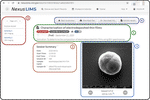Scientific Data Management
Last updated on
Jan 31, 2025

During my time within the Office of Data and Informatics at NIST, I have focused on working directly with other researchers to address data and workflow challenges through novel data management solutions. This work has involved both in‑depth technical proficiency as well as experience leading both project teams and federally‑funded working groups.
Selected highlights from my time at NIST include:
- Designed, implemented, deployed, and maintained usnistgov/NexusLIMS – a laboratory information management system (LIMS) to automatically harvest, categorize, and display data from dozens of electron microscopes and associated spectrometers (backend and frontend dev using Python, Django, SQLite, MongoDB)
- Published ETSpy – usnistgov/etspy – a HyperSpy extension package to facilitate electron tomographic data analysis (using Python, Jupyter, Sphinx)
- Proposed, architected, and implemented an internal staff scheduling application to manage in‑person room utilization during the COVID‑19 pandemic featuring calendaring, approvals, notifications, etc. Used by over 800 employees during the return to hybrid work schedules. (using PostgreSQL, Shiny, PostgREST, Office 365 APIs, Python)
- Identified and deployed an electronic lab notebook platform (ELN) for use by research staff at NIST (eLabFTW). Developed data models for microbial research workflows and an automated experiment metadata validation and export pipeline. (using LinkML, pydantic, Python, Web APIs)
- Co‑chaired a working group of the Materials Research Data Alliance (MaRDA) focused on producing recommendations for the use of LIMS in materials research environments (results published in the MRS Bulletin)
- Maintained and managed community for open‑source hyperspectral data analysis software – hyperspy/hyperspy (Python)
Publications
MaRDA FAIR Materials Microscopy and LIMS Working Groups' Community Recommendations
Managing, processing, and sharing research data and experimental context produced on modern scientific instrumentation all present …
NSF FAIROS Materials Research Data Alliance Working Groups to hold Town Hall Meeting at 2024 MRS Spring Meeting & Exhibit
Two Working Groups of the Materials Research Data Alliance (MaRDA) will hold a Town Hall Meeting at the 2024 MRS Spring Meeting & …
A Roadmap for LIMS at NIST Material Measurement Laboratory
Instrumentation generates data faster and in greater quantity than ever before, and interlaboratory research is in historic demand …
Gretchen Greene, Jared Ragland, Zachary Trautt, June W. Lau, Raymond L. Plante, Joshua A. Taillon, Adam Creuziger, Chandler Becker, Joseph Bennett, Niksa Blonder, Lisa Borsuk, Carelyn Campbell, Adam Friss, Lucas Hale, Michael Halter, Robert Hanisch, Gary Hardin, Lyle Levine, Samantha Maragh, Sierra Miller, Christopher Muzny, Marcus W. Newrock, John Perkins, Anne Plant, Bruce Ravel, David Ross, John Henry Scott, Chris Szakal, Alessandro Tona, Peter Vallone
NexusLIMS: A Laboratory Information Management System for Shared-Use Electron Microscopy Facilities
This work introduces NexusLIMS, an electron microscopy laboratory information management system designed and implemented by the Office …
Talks
Updates from the MaRDA LIMS Working Group -- A Community Discussion
Apr 22, 2024
Seattle, WA
Lessons Learned Building a Modern Microscopy Data Infrastructure at NIST
Oct 31, 2023
Munich, Germany
Introducing the MaRDA LIMS Working Group: LIMS Schema Development
Oct 24, 2023
Salzburg, Austria
Lessons Learned Evaluating and Deploying Electronic Laboratory Notebooks at NIST
Sep 12, 2023
Virtual (Munich, Germany)
Lessons Learned Building a Modern Microscopy Data Infrastructure at NIST
Oct 28, 2022
Denver, CO
Lessons Learned Building a Modern Microscopy Data Infrastructure at NIST
Oct 17, 2022
Virtual (Madison, WI)
Lessons Learned Building a Modern Microscopy Data Infrastructure at NIST
Sep 9, 2022
Virtual (Richland, WA)
Lessons Learned in Building a Modern Microscopy Data Infrastructure at NIST
Aug 3, 2022
Portland, OR
